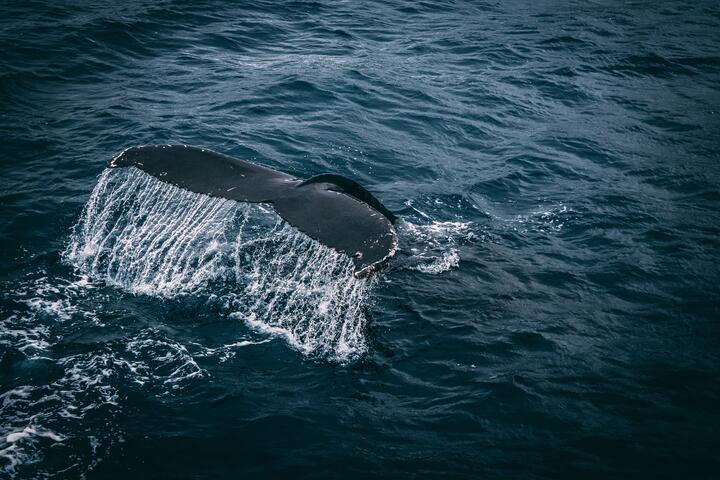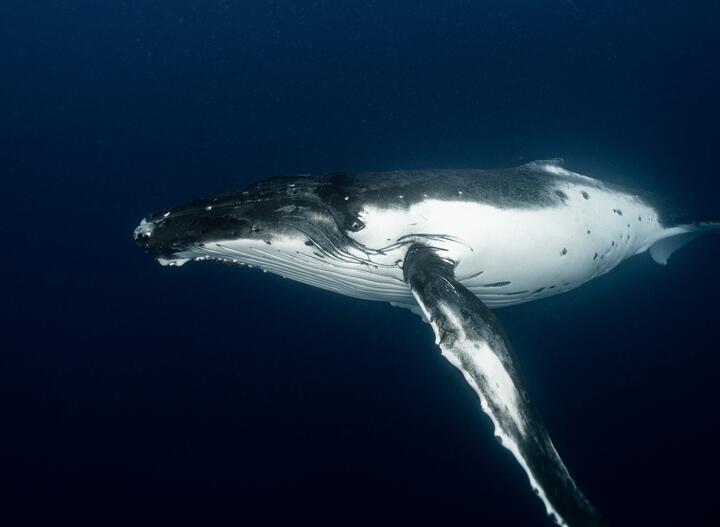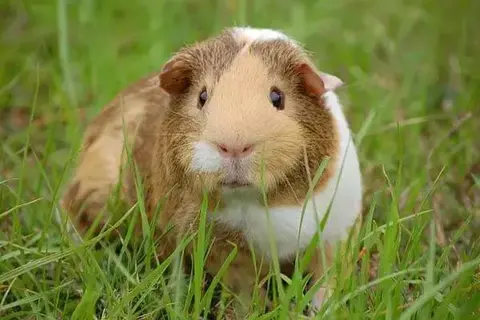Interesting Facts About The Blue Whale
Murphy ScottThe blue whale is the largest creature on Earth.
 Photo by Rudolf Kirchner on pexels
Photo by Rudolf Kirchner on pexelsToday we will tell you interesting facts about the blue whale. The blue whale is a marine mammal belonging to the baleen whale suborder Mysticeti. It is currently the largest creature on our planet, and perhaps the largest ever (this has not been proven, but there is every reason to believe it is). A blue whale can be as long as 33 meters (females larger than males) and weigh more than 150 tonnes. Blue whales live either in small groups (2-5 individuals) or (more often) as solitary individuals.
It would seem that the master of the sea, the blue giant should not know its equal, but the whales are not predators. They feed on plankton and small crustaceans. Blue whales slowly swim with their mouths open, taking in water (about 32m 3 ) with crayfish and plankton. The whale squeezes water from its mouth with its tongue, leaving its prey on the fringe. The whale eats up to 8 tons of krill per day.
The whales have enemies – man and orcas (hunting for young animals). Whaling was common, which, combined with pollution and natural mortality of whales has led to a sharp decline in the population of whales. 10,000 individuals – this is an approximate figure given by scientists studying this species of whale.
Although whales live for a long time (110 years maximum, average 80-90 years), their natural growth rate is quite low. The female gives birth once every two years, carrying a calf for about 12 months. A calf is usually 1, with twins occurring in 1 out of 100 cases. Blue whales are monogamous, and the male never leaves the female, not allowing herself to swim away even for a short time. Whales communicate by sound signals (frequency 8-20 Hz). It is proven that whales can hear signals up to 33 km away.
Grazing whales dive into the water to a depth of 140 meters, holding their breath for 8-10 minutes. On the surface, they breathe at a rate of up to 4 times per minute, but before and after diving their breathing increases. The whales can also dive deeper – whalers recorded dives to a depth of 500 meters, with the wounded giant did not dive out for 50 minutes.
Blue whales can not see well, have a poor sense of smell, and most likely lack a sense of taste, but hearing and touch at the proper level. The volume of the whale’s lung is over 3,000 liters. The heart of an adult whale weighs about a ton (owners of the largest hearts on the planet). The heart rate is 5-10 beats per minute, less often it reaches 20. The weight of a newborn whale reaches 3 tons!
Inside the mouth of the blue whale there are hundreds of pairs of mustache plates up to one meter long consisting of keratin (horn matter). The mustache is black and has the shape of a triangle. The mustache plays a key role in feeding the blue whales.
Although there is currently no threat to the species, the whales need to increase their population. Hunting whales is strictly prohibited and all measures are taken to protect the habitat of the blue whales.
Did you like interesting facts about the blue whale? Share it with your friends.
Facts About the Blue Whale
 Photo by Elianne Dipp on pexels
Photo by Elianne Dipp on pexelsThere are some fun facts about the blue whale. This baleen whale belongs to the parvorder Mysticeti and has a maximum length of 29.9 meters. This giant animal can weigh over 199 tons, making it one of the largest animals known to man. There are many fun facts about the blue whale, including how the species got its name. Learn more about this incredible creature and get enthralled by its colossal size.
The blue whale lives up to 80 years. The whales typically swim alone, but occasionally travel in groups of up to 60 individuals. The whales can generate up to 188 decibels of noise, and their hearing is incredible. They are the loudest animals on earth, and they can hear as high as four hundred meters away. There are many interesting facts about the blue whale, but there are a few that stand out.
The Blue Whale is the largest animal in the world. They can grow to be more than 100 feet long and weigh 200 tons. Not all blue whale populations and subspecies are the same, though, and the Antarctic population is the largest, weighing around one hundred tons. There are many other facts about the blue whale that you should know. You’ll be amazed at the scale of these enormous creatures. You’ll be glad you learned some facts about the blue whale before you set off on a trip!
The blue whale is the largest animal in the world. It is a marine mammal and grows up to forty meters in length. The biggest fact about the blue whale is that it does not have skin glands that can evaporate moisture. Despite this, the thickness of the blubber and blood flow are enough to keep the animal warm. This is the reason why the ventral portion of the whale has a yellow tint.
The blue whale has a very large and incredibly sensitive ear. It can communicate up to 1,000 miles away. Unlike other mammals, they can hear each other well. The sounds they make are loud and they can even scare small animals. Thankfully, commercial whaling has been discontinued for the blue whale, but its population continues to decline. A number of other threats to the whale are marine contaminants and noise pollution. The sound they emit can also kill small animals.
The blue whale has a blowhole similar to ours. Its head is huge and extends almost three times as far up as ours. A blue whale has a heart the size of a medium-sized car. Its blood vessels are large enough to make a baby crawl! Luckily, there are many facts about the ocean and the blue whale. There are so many amazing facts about the blue whale. There are so many fascinating facts about the whale that will make you want to learn more about it!
The blue whale is one of the largest animals in the world. It has a tongue that reaches the length of an elephant’s. Its heart is the size of a Volkswagen Beetle. The Blue Whale is the largest animal in the world. It is estimated that there are only 5,000 to 12,000 of these majestic creatures in the world. If the population were still more than ten thousand, it would be a thriving animal.
The blue whale is the largest animal on the planet. It is also the largest animal to have ever lived. Although it is the largest animal in the world, it is also the most fragile. Its esophagus is too small to allow it to swallow human prey, so it relies on its fat for energy. This means the blue whale’s esophagus is remarkably thick to survive in the cold waters.
Blue whales are not threatening predators. Their stomachs can hold up to four tons of food. Their mouths have 270-400 baleen plates that filter water. The blue whale uses its tongue to displace water through filtering teeth and communicate with its surroundings. Its vocalization is one of the most unique facts about the blue whale. If you love learning about the blue whale, then you should definitely read this article!
- CatsThe Cat Rescued A Kitten Stuck At A Height

- WildlifeWhat Is The Lizard Diet? Lizard FactsBy Karla Miller

- WildlifeAmazing Facts About Polar Bear CubsBy Evelyn Star

- WildlifeInteresting Facts About Hermit CrabsBy Evelyn Star

- WildlifeHow Much Does Baby Giraffe Weigh?By Karla Miller

- Cats25 Interesting Facts About CatsBy Amelia B

- Wildlife7 Interesting Facts About The JaguarBy Khai Dove

- Rodents24 Interesting Facts About Guinea PigsBy Charlotte Green

- InsectsWhat Do Dragonflies Eat?By Charlotte Green

- WildlifeInteresting And Surprising Facts About A White LionBy Evelyn Star
